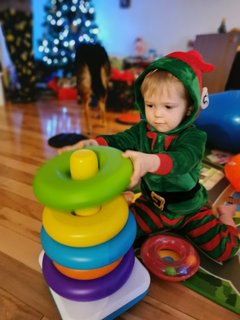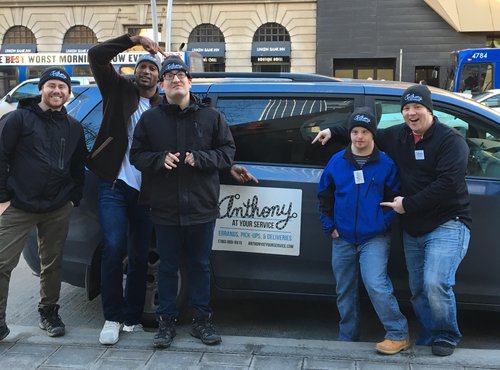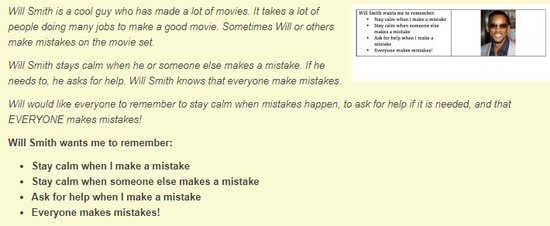In This Issue
The opinions, beliefs and viewpoints expressed in this publication are those of the authors. They do not necessarily reflect the opinions, beliefs, viewpoints or official policies of Autism Society Alberta.
|
|
|
End article-->
The Best Christmas Ever!
Karla Power
 Considering what year it was, it might seem bizarre that I am writing an article entitled “The Best Christmas Ever!” In reality, last year was a very hard year for our family, like many others. Not being able to visit friends and family has definitely taken a toll on us all. Considering what year it was, it might seem bizarre that I am writing an article entitled “The Best Christmas Ever!” In reality, last year was a very hard year for our family, like many others. Not being able to visit friends and family has definitely taken a toll on us all.
In December, my husband and I both took turns in isolation, and Alberta was pretty much locked down. While most teachers were looking forward to Christmas vacation, I was sort of dreading it, since I knew the loss of our routine would provide some difficult days with the boys.
Although I would have liked to be able to visit people throughout the holidays, I have to say that we had a wonderful Christmas as a family! The weather was great, and we were able to get out for daily sled rides and walks. We also took the boys sliding a few times, and Paddy even got to try going down our local ski hill on a sit ski. I can’t say enough about businesses who make  accommodations like this, so that our kiddos can have wonderful experiences! accommodations like this, so that our kiddos can have wonderful experiences!
As Christmas Day itself started to come near, I felt physically prepared in the sense that everything was bought and wrapped, but wondered what this year would bring. You see, every year at Christmas, we hold our breath a bit to see how Paddy will react. Some years he seems indifferent towards the gifts, stockings and the holiday excitement, and other years he seems agitated by it all.
This year, though, we got to experience what most typical parents do on Christmas morning. Both Paddy and Kelton woke up with a great sense of excitement, and when we went downstairs, they seemed almost giddy about the gifts that Santa brought them.
For the rest of the morning, we unhurriedly opened gifts with them and happily watched as they played with their new toys. Kelton was excited  for almost everything he received, whereas Paddy showed an interest in a few select gifts. We took breaks throughout the morning, connecting with our family through FaceTime, and then going back to the gifts. The whole experience took about five hours, but it was seriously the best Christmas ever! for almost everything he received, whereas Paddy showed an interest in a few select gifts. We took breaks throughout the morning, connecting with our family through FaceTime, and then going back to the gifts. The whole experience took about five hours, but it was seriously the best Christmas ever!
Even though we couldn’t be with our extended family and friends, we were able to bring joy to both of our boys. And although we know that Christmas is about much more than gifts, I would be lying if I said I wasn’t filled with joy whenever I saw my children light up over a new toy. This is something we have been waiting five years for, and it was worth the wait!
|
|
|
Getting Ready To Drive
Kitty Parlby
A typical rite of passage towards independence involves learning to drive, getting a driver’s licence, and perhaps buying a car. Most often, this starts somewhere between the teen years through young adulthood. But accomplishing these goals can be more complex for our autistic friends and family. Many people have asked questions on this subject, often unsure of how it works in Alberta. So I decided to tackle it!
In Alberta, Driver Fitness and Monitoring is responsible for reviewing driving privileges of individuals and assessing their ability to safely operate motor vehicles. To become a registered driver, first you need to get your Class 7 learner’s licence by passing the knowledge test. You can take the test as many times as you like, at around $20 each time, but you can only take it once per day. The unlimited tries are great for some autistic individuals, but not needed for others. It pays to study hard and do a lot of practice tests, which are helpful to gauge your knowledge, and perhaps ease  your test anxiety as you feel more confident.If you need extra help, there are ‘learner’s licence prep courses’ put on by registry businesses; just Google them. Various registries offer different ways to take the knowledge test, including online, on paper, and some even have it available as an oral test. your test anxiety as you feel more confident.If you need extra help, there are ‘learner’s licence prep courses’ put on by registry businesses; just Google them. Various registries offer different ways to take the knowledge test, including online, on paper, and some even have it available as an oral test.
The form you sign to receive your Class 7 learner’s licence includes medical questions. Many parents ask if their child has to disclose that they’re autistic. I spoke to multiple registry businesses about this, and some of them instantly said yes, until I delved into the wording of the medical questions with them. However, it is true that you must disclose anything that could impair your driving. Here’s the gist of it: if your autism symptoms might impair driving in any way, then you need to disclose that you’re autistic, at which point there is a medical form for your doctor to fill out. For the safety of your autistic family member and others, it is important for everyone to be honest with themselves (and the registry agent) about capacity regarding driving skills and attention to surroundings. Unsure if you or your teen lacks driving capacity? You can always pass on that decision by disclosing that you/they are autistic, and they’ll give you the medical form for your doctor.
Eventually you may be ready to take the road test for a Class 5 driver’s licence, the standard licence used to drive personal vehicles. You must be 16 or older, and you must have had a learner's license for at least one year. You can take the road test as many times as you like, but you can only take it once per day. At this time the paperwork will ask again about any conditions or disabilities that may affect driving. Driving lessons may be a great option for some. Even if you learned to drive from a friend or family member, you could still take a couple of driving lessons before your road test to increase your chances of passing and to decrease unease concerning the test. You must drive for two years with a Class 5 graduated driver's licence (with no suspensions for the last year) to be able to upgrade to a full Class 5 driver's licence.
Now let’s talk about insurance. I spoke to several insurance agents and was told that you do not have to disclose that you’re autistic when applying for insurance, and you cannot be denied insurance for being autistic. Anything to do with fitness to drive is considered accounted for when you go through driver’s registration and testing. However, I found that individual agents with less experience were quite unsure of the answer. One further note: some parents decide to not have their child’s insurance under their policy, but instead have them get their own insurance. This is to prevent any driving infractions your teen may have being reflected in your insurance rates.
 You should also know that a person can own a car even if they can’t drive. My son Eric, who is 24, owns his own car (paid with money saved up from AISH), and has his own insurance policy. His community aide worker is listed as the primary driver. We did this because paying mileage for his aide to drive him to activities and work experience in her car every day added up to a mileage bill of $450-$500 every month. As we live in rural Alberta, driving places racks up a lot of kilometres! You should also know that a person can own a car even if they can’t drive. My son Eric, who is 24, owns his own car (paid with money saved up from AISH), and has his own insurance policy. His community aide worker is listed as the primary driver. We did this because paying mileage for his aide to drive him to activities and work experience in her car every day added up to a mileage bill of $450-$500 every month. As we live in rural Alberta, driving places racks up a lot of kilometres!
There is a lot to consider when pursuing a driving licence. If your autistic family member will not be able to drive, keep this in mind when making plans for transitioning into adulthood. It may affect where they choose to live, as some places have better transportation choices than others. It could also affect what services or activities they have easy access to, and what jobs they can apply for. Whether you are able to drive or not, foresight and a little creativity can facilitate a rich and purposeful life!
Kitty Parlby is the mother of a young adult with autism. She is a former special needs Educational Assistant and an autism speaker and consultant with Autism Inspirations. She currently works as a Family Support Worker for Autism Society Alberta.
|
|
|
Autism CanTech


Autism CanTech! provides Autistic youth with robust supports to succeed in their careers, and empowers participants to be supported and independent in the workforce, with an autistic-centred approach.
Successful applicants will be enrolled in a six-month training program that will prepare them to perform data processing roles for a variety of businesses in the digital economy, including those in education, finance, government, software, and healthcare. Autism CanTech! gives Autistic youth a chance to learn entry-level employability and technical skills for the digital economy.
This unique program offers participants an education tailored to their individual needs by working directly with participants in small class environments to develop practical and job-transferable skills. One-to-one career coaching services, assistive technology, and a no-test/no-exam curriculum are part of the barrier-free approach to learning.
Click here to learn more and to sign up
|
|
|
End article-->
The Unexpected Path
Deborah Barrett
It’s been almost 30 years since we got Anthony’s diagnosis – well before there were treatments and therapies for children with autism. There were several years of “rough sledding,” learning how to “listen” to my non-verbal, passive youngster, learning what helped him in a world still devoid of the internet, let alone programs to help parents like me.
 Somehow, we made it through to junior high school, where he thrived in a program devoted to helping children like Anthony learn and grow. We made it through high school, with Anthony thriving in the learning situation and looking forward to more years of the same. We loved the growth, joy, and learning we saw in Anthony. And we tried to fight back the dread at what lay ahead – the void into which adults like Anthony were thrust when school came to an end. Somehow, we made it through to junior high school, where he thrived in a program devoted to helping children like Anthony learn and grow. We made it through high school, with Anthony thriving in the learning situation and looking forward to more years of the same. We loved the growth, joy, and learning we saw in Anthony. And we tried to fight back the dread at what lay ahead – the void into which adults like Anthony were thrust when school came to an end.
For someone who is largely non-verbal, Anthony is a master at making his needs known. He made sure we knew he expected to have a good and meaningful life when school was over for him. We knew (and feared) we would have to create something out of nothing to ensure his life had purpose and connection to the community when there was no more school.
Anthony at Your Service was born out of Anthony’s interests and loves – being outdoors, driving around, seeing new places, but never staying too long, carrying things, and helping people. A customized delivery service met those needs for Anthony. Surprisingly, it also met a need in the community for customized deliveries – eight years before COVID!
Anthony at Your Service met Anthony’s needs for meaningful activity in the community. He was challenged in a good way, but so were we. We learned that if Anthony’s business was going to be successful and sustainable, we had to employ more people with disabilities. When we did that, we had to learn how to coordinate our service teams and ensure our customers’ needs were met in the way they wanted. It was Anthony’s business, and he was thriving, but now it had grown. It seemed to take on its own life. We had to learn the rhythms of our teams, our customers and the communities they serve. We had to learn that different cities, and now a different province, work differently.
 This past year, the challenge has gone well beyond Anthony. Anthony at Your Service has been working with TELUS helping develop their new markets. To respond to their needs, Anthony at Your Service branched beyond Edmonton and Calgary to Fort McMurray and about a dozen locations in British Columbia. At the same time, larger firms from Alberta, like EPCOR and BioWare, are looking to Anthony at Your Service to provide some of their deliveries. The little business that was started to keep Anthony engaged has grown again. Today, we are learning how to keep track of all the jobs and all the teams, while continuing to build relationships with individuals, customers, and communities. This past year, the challenge has gone well beyond Anthony. Anthony at Your Service has been working with TELUS helping develop their new markets. To respond to their needs, Anthony at Your Service branched beyond Edmonton and Calgary to Fort McMurray and about a dozen locations in British Columbia. At the same time, larger firms from Alberta, like EPCOR and BioWare, are looking to Anthony at Your Service to provide some of their deliveries. The little business that was started to keep Anthony engaged has grown again. Today, we are learning how to keep track of all the jobs and all the teams, while continuing to build relationships with individuals, customers, and communities.
Many years ago, I gave a talk about being a parent of a child with autism. I called it To Be So Blessed. I felt that the challenges of autism were challenges that could help us be more responsive, challenges that would help us embrace a life that was going to go down an unexpected path.
Today, Anthony is an adult, and he has a job and paying work, even during COVID. His job has become part of his identity. Today, the unexpected path has been the source of opportunity to learn, create, and connect with a whole range of big-hearted people who want to work and participate in more inclusive workplaces in more inclusive communities. From people like Anthony, to people like me, to customers like TELUS and the others, the unexpected path offers the blessing to continue to learn how to contribute to our communities on a daily basis. The blessing of learning – the blessing of Anthony – the blessing of the unexpected path continues.

Deborah Barrett is a mother, unexpectedly turned entrepreneur to ensure a good life for her son. Anthony at Your Service is currently looking for more workers in Edmonton and Calgary. For more information contact Anthony at Your Service at info@anthonyatyourservice.com or call 403-402-7504 in Calgary and 780-800-9915 in Edmonton.
|
|
|
Social Narratives – Part 3
Carmen Moore
In this month’s edition of our ongoing series, I’ll be taking one last look at social narratives. Social narratives are typically associated with social stories, but power cards are also a major component of SNs. For this third part, we will look at more specific examples of both social stories and power cards. Research shows that these tools are effective for individuals from the ages of 5 to 22, although you shouldn’t be afraid to try them with older or younger learners, if appropriate. Much of the information in this article is from the related AFIRM online module (link below).
When it comes to determining which tool works best for a given social goal, here is a simple rule of thumb: Social Stories help learners with ASD understand social situations and other people’s perspectives; Power Cards use a learner’s special interests to describe the rules and behavioural expectations of social situations.
Power Cards typically involve a scenario that the learner may find challenging in some way (behaviourally, academically, socially, etc.). Then, a list of expectations or rules is clearly laid out to follow. These can be created on index cards, for example, and can be kept – laminated for durability, if needed – for regular reference. They are portable, so they are easy to take to different locations. The learner’s special interests can be incorporated into the Power Card, too. You can write Power Cards specifically for the situation and learner to help personalize them and address the specific goal, but you can purchase premade ones, as well. Some examples are below.


Whether you choose a social story or power card, find a distraction-free space to introduce and use it. The learner will be able to focus on it, and the chance of understanding will go up. Explain to the learner what the social narrative is about, and which aspects are important to keep in mind while reading. After the learner has read the social narrative (or been read to, depending on their age or reading ability), ask the learner 3-5 comprehension questions about the narrative. The learner’s answers will help you determine if the learner understands the concepts in the narrative. Consider using role plays to provide the learner with an opportunity to practice the target skill or behaviour.
SNs are also proven to work better if read, shared, or reviewed directly before the target behaviour or situation is about to happen. For example, if the learner is about to go for a job interview, reviewing the SN right before the interview is the best bet for success.
Social Stories or Power Cards can be an effective tool when discussing more personal or sensitive topics (hygiene-related, relationship-related, etc.), as well. They can help to lay information out clearly and plainly, in a way that can help the learner to understand. Having text and/or pictures can be helpful, in terms of providing extra context and information, depending on the learner’s ability to take in new information. It can also help to have a focal point to look at when discussing sensitive topics.

If you want more information on how to begin using social narratives, as well as how to create or purchase them, ask your child’s school or teacher, a speech pathologist, or any autism specialist. You can also do your own research, as there is a lot of information available on this topic. I have witnessed the power of this strategy firsthand, and firmly believe in the power of SNs. This tool can (and sometimes should be) used in conjunction with other strategies, such as visuals, prompting, or using reinforcement for attention and/or success, as well.
In our next issue, we will begin covering another evidence-based practice that will serve as one more ‘power tool’ for your proverbial ‘toolkit’ of what is proven to work.
If you are interested in checking out the free online AFIRM modules, click here to view the Social Narrative module, and click here to view the entire series.
|
|
|
A Place to Call Home


Please share your experiences about housing for Autistic adults. Together, we can develop better housing solutions for Autistic adults!
The project "Housing Through an Autism Lens" is addressing the difficulties many Autistic adults face in finding and keeping the homes they want and need, especially when they are young adults and seniors. The project will develop pathways to secure housing for Autistic adults that includes supports and services as needed, as well as solutions for home builders. Long term, these pathways will increase safety and reduce risks, including the risk of homelessness, for Autistic adults.
The project will collect micro-stories of housing experiences from Autistic adults as well as caregivers, professionals, housing providers and other stakeholders.
Please share your story and share this opportunity with others!
Click here to begin
|
|
|
End article-->
Successful Transitions from One Activity to Another for Individuals with ASD
Maureen Bennie

From the Autism Awareness Centre Inc. Blog:
Transitioning from one activity to another is a part of life at home, work, school and in the community. Transitions involve stopping one activity and starting another, or moving from one location to another to begin something new. Studies have shown that up to 25% of the school day may be spent in  transition activities such as changing classrooms, going outside for recess, lunchtime, putting items in lockers, or getting materials for a task. There are similarities in the workplace and at home, such as moving from one task to another, attending meetings or social events, eating meals, and leisure breaks. transition activities such as changing classrooms, going outside for recess, lunchtime, putting items in lockers, or getting materials for a task. There are similarities in the workplace and at home, such as moving from one task to another, attending meetings or social events, eating meals, and leisure breaks.
Without preparation or support for transitions, many people with ASD find them stressful or anxiety provoking. Challenging behaviour may happen at this time.
Transitions are difficult because:
- there is a strong need for predictability
- there may be a lack of understanding of what activity comes next
- they may feel upset moving from a preferred activity to a non-preferred one
- a pattern of behaviour may be disrupted
- a change in environment may be disconcerting (such as going from indoors to outdoors, or moving from a quiet place to a noisier one)
- multi-step directions for the next activity may not be understood
- transition cues are not recognized (for example, students putting on their coats means recess is starting)
- the activity they are transitioning to is more demanding or not liked
- there is difficulty sequencing information and recognizing relationships between steps of an activity
- a person may have higher levels of anxiety, which impacts behaviour during moments of unpredictability
Preparing for Transitions
There are a number of preparation strategies to use that help create predictability for transitions.
Visual Timers
A visual timer helps a person to see how much time is left before an activity ends and a transition will begin. Time is an abstract concept, so make it as concrete as possible. A Time Timer has a red segment that disappears as time passes. For shorter time periods that only last a minute or two, consider using a sand timer. Sand timers come in a variety of sizes and time durations, like 1, 3, or 5 minutes. These can be great to use for quick tasks like brushing teeth, putting on a coat, or putting something away. When the sand runs downs to the other side, time is up.
 For older children and adults, there are a number of timer apps now available, including the Time Timer. Click here for time apps, as well as other types of timers. For older children and adults, there are a number of timer apps now available, including the Time Timer. Click here for time apps, as well as other types of timers.
Using Visuals to Count Down
Using visuals to count down is a way to be flexible with increments of time. The visuals can be things that appeal to the individual and are meaningful to them, like a favorite colour, shape or character. For example, there can be five cards numbered 1 to 5 and placed vertically in numerical order, with the end of the task at the bottom. You would start by removing the #5 card, moving all the way down to #1. Some examples of what visual countdowns look like can be found here.
I used to make some of my own time tools to have manual control of time. If a task was going well, I could extend the time using my own tools. How I did this was to make a cardboard strips and put a piece of Velcro across it. I then took poker chips and put Velcro on the back of those. I would then remove the chips off the strip as time was passing to show that a task was progressing. Another tool I used was the sit wheel; it’s a wheel on top of a circle that has a picture of someone sitting down. I would then move the top circle along, covering up the sitting pictures to show the passage of time.
Click here to read more – Open the link and scroll down to "Visual Schedules, Different Ways"
|
|
|
Upcoming Autism Webinars

Designing Sensory Spaces for Children and Teens at Home
Thursday, February 25, 2021 – 10-11 am (Mountain Time)
Featuring Paula Aquilla, OT
 Parents and children are spending more time together during COVID. Schools have been closed and restrictions have been made on community spaces, making home ‘the space’ for everyone. In this webinar, you will learn what to consider when designing your space, and how to enlist your child in designing the space they will use. The same space can have more than one purpose – learn how to change the space with multiple purposes in mind. Parents and children are spending more time together during COVID. Schools have been closed and restrictions have been made on community spaces, making home ‘the space’ for everyone. In this webinar, you will learn what to consider when designing your space, and how to enlist your child in designing the space they will use. The same space can have more than one purpose – learn how to change the space with multiple purposes in mind.
Learn More
The Brain and Autism: Linking Neurology and Interventions to Address Academic and Behavior Challenges
Thursday, February 11, 2021 – 10-11am (Mountain Time)
Featuring Dr. Brenda Smith Myles
 This session will provide a brief overview, in layman's terms, of some of the latest neurological research connected to autism. It will cover brain research related to academics/learning, social, sensory, and regulation. This research will then be linked to practical, easy-to-use evidenced-based interventions that can help autistic students learn. This session will provide a brief overview, in layman's terms, of some of the latest neurological research connected to autism. It will cover brain research related to academics/learning, social, sensory, and regulation. This research will then be linked to practical, easy-to-use evidenced-based interventions that can help autistic students learn.
Learn More
|
|
|
End article--> |
|